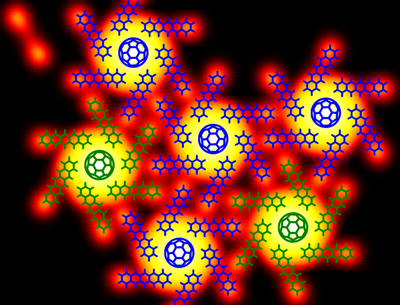Chiral 'pinwheels' self-assembled from C60 and pentacene


In a recent study from the Electronic & Magnetic Materials & Devices and Theory & Modeling groups at the Argonne National Laboratory, C60 and pentacene (Pn) molecules, two workhorses of organic electronics and opto-electronics, are observed to self-assemble on a Cu(111) surface into in-plane "pinwheel"-shaped and chiral heterojunctions. Calculations confirm that the heterostructures are energetically favorable conformations and reveal electron charge transfer from the Pn to the C60 in this chiral morphology, a critical signature of electronic heterojunctions.
The demonstration that these highly symmetric acceptor and donor molecules, which are widely used in organic electronics and photovoltaics, form chiral structures suggests a potential path to integrating chiral selectivity with optical absorption and charge separation, even with highly symmetric achiral molecules. Studies in an ultrahigh vacuum (UHV) system with surface preparation and scanning tunneling microscopy (STM) capabilities were critical to characterizing the self-assembled systems at the atomic scale in an ultraclean environment. In addition, the computing cluster "Carbon" supported density functional theory calculations with van der Waals corrections on these complex structures.
More information: Smerdon, J. et al. Chiral 'Pinwheel' Heterojunctions Self-Assembled from C60 and Pentacene, ACS Nano, ASAP (2013).
Journal information: ACS Nano
Provided by Argonne National Laboratory


















